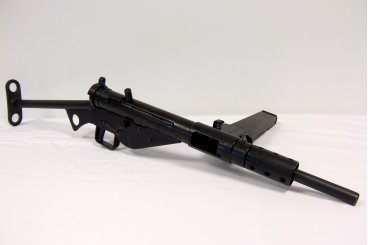

Inert and non-detonating replica according to law, complete with red cap (it can be removed on request for shipments to the EU).

This story originally appeared at Historical Firearms. Dimensions: length: 76cm, weight: 2,094g. The British Army’s own special forces finally replaced their suppressed Stens with suppressed MP5s in the 1980s. II(S) because it could be easily disassembled and compactly stored in a rucksack. units of the Military Assistance Command Vietnam, Special Operations Group also favored suppressed Stens for clandestine operations such as long-range reconnaissance, prisoner-snatches and assassinations. The British Army deployed them in the counterinsurgency operations in Malaya and Kenya during the 1960s.Ī suppressed version of the Sterling submachine gun, the 元4A1, formally replaced the suppressed Stens in 1966, but commando units such as the Special Air Service and Special Boat Service held onto their suppressed Stens for many years. II(S) obsolete in April 1945, the weapon remained in service for several more decades. While the British Army officially declared the Mk. II(S) during the war and designated them “MP 751(e).” “What losses they might save and what dangers they might avert! How wonderful, in case of an unexpected meeting with an enemy detachment, to be able to fire without the reports attracting the attention of other enemy groups!” “What splendid possibilities the use of these silencers offered,” he noted when he finally obtained one. Originally best known for its use with British Para units. officer who took part in the rescue of deposed Italian leader Benito Mussolini in 1943, went to great lengths to acquire a suppressed Sten. Sten Mk2 & Mk5 Wood foregrip adds great stability to this SMG. While they could not be fired in fully automatic beyond short bursts, if fire was kept to single shots or two-round bursts, then the weapon avoided serious overheating and fatigue. The silenced Stens were extremely effective. II(S)’s, but was more difficult to disassemble and service. VI’s suppressor was shorter than the earlier Mk. V with the canvas insulating-shroud of the Mk. VI(S) combined the stock furniture and receiver of the Mk. IV in any variant, instead taking the more-robust Mk. It seems that a silenced Sten based on the aborted Mk. The guns also saw action in the Far East and with special reconnaissance parties. II(S)s saw combat in Europe in 1943 in the hands of frontline agents of the SOE. Also, from the operator’s perspective, a special catch allowed the magazine to be slid partly out of the magazine housing and the housing rotated 90 degrees counter-clockwise, together covering the ejection opening and allowing the weapon and magazine both to lie flat on its side.At top - a Sten Mk. With total construction cost of a home built at about 110. Photographs detail manufacturing procedure, blueprinted receiver plans and STEN MK II RECEIVER TEMPLATE.
#Sten mark 2 review manual
A removable barrel was now provided which projected 3 inches (76 mm) beyond the barrel sleeve. The Sten MK II construction manual is a complete 'how to' book utilizing kits from ARMEX, SARCO, etc. The flash eliminator and the folding handle (the grip) of the Mk I was eliminated. It was a much rougher weapon than the Mk I. The Mark II was the most common variant, with two million units produced. The Sten was small and could easily concealable divided into several parts, and, therefore, was appreciated for operations of the partisans in Europe. The Sten submachine gun used cartridge pistol 9 x 19, which was a bonus if captured German ammunition, as they could use. Some four million Sten of several versions were produced during the 1940s. The name STEN is an acronym derived from the names of the leading designers of weapon: the Mayor Reginald Shepherd, Harold Turpin, and Enfield, the place where is located the Royal Small Arms Factory (RSAF) of London. Its most notable features were its simple design and low cost of production. It was used by the forces of the Commonwealth during World War II and the Korean War. Thus was born the Sten submachine gun, a weapon with a debatable design and reliability, but also one of the most easily recognizable of the Second World War would end up being used by both airborne troops and special operations forces as resistance to almost all the countries occupied by the Germans. The government was in urgent need to equip their soldiers with a weapon of own production. Sten Mark II, 9 mm caliber, United Kingdom 1940 (World War II).Īuthentic replica of this machine gun that was born in 1940 when England was alone and threatened by an imminent invasion by Germany.


 0 kommentar(er)
0 kommentar(er)
